
This is the Biolite Campstove cooking a pan of beans. I let the flame go for a while because I hadn’t charged the battery beforehand as instructed. It didn’t matter. When I plugged the phone in to charge it a few minutes later it immediately started charging.
Biolite CampStove $129
https://www.biolitestove.com/
Power Practical PowerPot 5w/10w & Lithium 4400 Battery Bank $99-$149
https://powerpractical.com/collections/generate
Tegmart Devil Watt – 10w/15w Open Flame Generator $235-$304
https://www.tegmart.com/propane-stove/
TegMart Devil Watt – Woodstove Generators 15w – 100w $234-$725
https://www.tegmart.com/wood-stove/
Thermoelectric generators are not a new technology. “TEG” power was discovered in 1821, but I have to admit, it is new to me. I recently discovered three consumer products that create electricity from direct heat, and all three of them have survival applications. One of them is the best bugout or camp stove I have ever encountered, and I would take it one step further and say that it is the best bugout cooking solution I have ever encountered, period. A second is made for generating electricity while you cook your dinner, and I had marginal success with it. The third is made for a high level of direct heat electricity production, and you can drive it from your rocket stove, a camp stove, and they have models from 10 watts up to 100 watts that use waste heat from your wood stove.
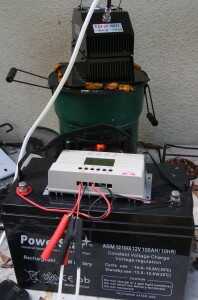
This is the open flame version of the Tegmart Devil Watt 15 watt generator, on my Rocket Stove, connected to a storage battery through a charge controller. It is made for a propane or gasoline stove, but my Rocket Stove got up to about 4 watts.
I would split these up into three articles if I didn’t believe that time may be getting short, and that survival budgets are full of hard choices. Please check out all three of these great products and decide which fits your needs the best. I have yet to do my “survival computing” article, but if you check out the material we have already covered, just being able to charge your smartphone can give you a cheap geiger counter, an off-grid topo-gps, and even a worldwide (SDR) radio. The other day I found some apps that generate and read Morse code, and if you want to “talk” to loved ones across the continent or across the world in a grid down situation, Morse code, or “CW,” is most likely going to be the way you’ll do it on the cheap. Yes I have an article explaining that coming, but if you are handy with soldering electronics, search Ebay for “qrp transceiver” and get going. Being able to charge your phone, and even a big 12v storage battery, are really possible with these TEG generators, so don’t take them lightly.
The Biolite CampStove
If you have read this column for the last year and a half, you know that I am a huge fan of the “Rocket Stove.” The Rocket Stove concept is somewhat complex. The best way I can describe it is that as wood and other biomass like leaves burn, they heat everything else in the stove at the same time. This releases volatile gasses, that in an open campfire, mostly don’t burn, and just float off. In a Rocket Stove, the gasses are trapped in an insulated, superheated chamber and forced to burn. This gives you an unprecedented amount of BTUs from a very small amount of fuel. In practice, that adds up to cooking dinner from a handful of sticks. To give you an idea of my practical experience, all of the Rocket Stove articles I have done here just on this article used up what was a small armload of dead branches, many of them half eaten by bugs.

See below for my pictures. The big difference for me with the Biolite stove compared to a real Rocket Stove is that the internal battery runs a blower, and that blower helps you to light the stove easily with ground pick up tinder, and burn large chunks of damp ground wood with no problems at all.
My tribulations with the Rocket Stove have been getting the thing lit and burning good, because I insist on using wood and leaves that have been left outside. I also almost never use any of the tinder from my firestarting article, and my one extravagance is to use matches and sometimes a piece of paper or a napkin to get things going. To me, it isn’t valid to test any of these products under ideal conditions, but I always end up getting the stove going.
The other issue with the Rocket Stove is one of pure BTUs. Even gassifying the biomass, there is only so many BTUs in that material, and it takes some serious BTUs to boil water and cook your dinner. I have even successfully canned food with a canner using a couple small branches picked up off the ground in my Rocket Stove, but it was not easy. When I get done with one of these articles I stink like a chimney for three days, because I have to repeatedly blow on the embers to get fresh fuel into a “raging fire” quickly.
The Biolite stove solves both the lighting problem and the BTU problem with a built in electric blower fan. It’s TEG generator charges an internal battery pack built into the stove. This makes for easy lighting, because the blower “fans” the flames and gets even wet fuel going instantly with a little bit of burning tinder. For BTUs, I was able to boil the water in the pictures here in less than two minutes, for what would otherwise take 20-30 minutes.
Also, within about 3 minutes, my phone started charging via the 5 volt plug on the front of the stove. The Biolite supposedly charges at two watts on low, and up to 4 watts on high. I didn’t use the high, but even at low I didn’t get the “You Should Use the Charger that Came With Your Phone” message from Android. A regular wallwart charger is around 1 amp for phone sized, which is 5 watts at 5 volts. There is no question that you could use this to turn your phone on periodically to get a beaaring, check the topo in front of you, and even make a radio contact.
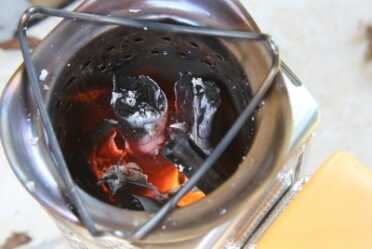
The downside, if there is a downside (NOT), is that the fuel burns really fast. This is well after my water was boiled and beans almost cooked, and phone charging a few percent.
The Biolite does burn fuel really fast. I have some branches that are about an inch and a half thick that I have used for several of these articles, and with the regular Rocket Stove I usually split them with a hatchet so that they burn faster. With the Biolite, the thickness was a plus, because air is being injected into the chamber, allowing the wood to burn much faster with much less surface area. The “logs” the length of the stove were gone in 10 minutes, but in that time I had already cooked my beans and charged my phone a couple percent. If you are in an area with a lot of fuel on the ground, don’t even think twice about this stove being a worthy investment. For burning available ground fuel that has a high percentage of moisture, you can’t do better.
The Power Practical Powerpot

The first of these products I tested were the PowerPot. This is the 5 watt, the 10 watt, and their lithium storage batter that has a nice flashlight built in.
But what if you live in the city? Or even suburbia? With nicely trimmed trees around as your exclusive source of fuel, you aren’t going to get a lot of cooking done without a lot of walking. Gasoline, however, will be in plentiful supply. All of your neighbors who ignored your urging to prepare for what is coming will be dead, and their cars will either be sitting in front of their house or stuck on the road. If you have a siphon (search Amazon/Ebay for “liquid transfer pump”) and a gasoline stove, you’ll have all the cooking fuel you need for years, in sealed containers just waiting for you to take it. Gasoline, and “dual fuel” stoves can be found on Ebay for under $50, and I actually saw a single burning Colelman at Walmart the other day for like $65 as well.

Initially I was dissapointed with the PowerPot because using water in the pot as a heatsink needs a lot of BTUs, and the Rocket Stove doesn’t have a lot of BTUs. But then I realized that for most people in cities, a gasoline stove is probably your best option for cooking. This is the 5 watt running at about 3/5ths with this single burner gasoline stove.
I hope to get to a fuel comparisons article at some point, but I can tell you that I learned a ton from Steven Harris’s fuels video, for which he gets $14.95 on his website. When it comes to BTUs you can store, there is not even a close comparison to regular old Gasoline, and with Pri fuel additive, it lasts almost indefinitely. Search Ebay for “gasoline stove” or “dual fuel stove” and you’ll find single burners for under $50 and doubles for under $100, sometimes much less used.
There are two sizes of PowerPot, 5 watt and 10 watt. But beware, these are not for use with a Rocket Stove in my experience. There just isn’t enough BTUs, becuase you are using water as a heat sink and there is no metal even close to water in the efficiency of heat transference. Technically could you use these pots with a Rocket Stove dry? I don’ know and I haven’t tried it, but as instructed, I would stick to gasoline stoves with the PowerPot. See the pictures for more.
The Devil Watt TEG
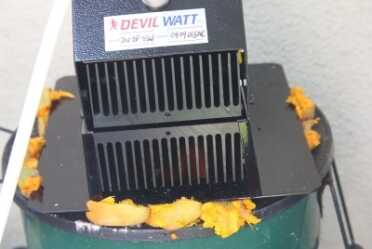
This may seem silly, but I try to solve problems with things I can find on the ground when I am working on survival stuff. I wanted to seal off the bottom plate of the 15 watt open flame Devil Watt so I used these fruits that fell from one of my trees. I don’t know if you can eat them, but they make a great seal to get the power rocking along.
If you plan to stay in one location and that location has plenty of fuel, there is really no comparison in a consumer TEG product to the Devil Watt line from Tegmart. The device I tested is their smallest, a 15 watt, and I tested the open flame version. With a Rocket Stove I knew that I was not going to get more than a few watts, and in my tests I was able to get a steady .3 amps (at 12v), which is about 4 watts. As you can see from the pictures, I hooked the Devil Watt up to a solar charge controller to see how much throughput I was actually getting.
The open flame version uses 4 TEG pads mounted between two huge aluminum heatsinks. The top heatsink, on the “cold” side of the pad, has a fan that blows cool air down onto the heatsink, and the electronics to convert the small voltage from the TEG pads into the 12 volts that are supplied from the charging cord. The bottom heatsink is in direct contact with the flame, and since the pads can take temps up to 842 degrees, you can actually use this device with a gasoline or propane flame.

I was able to maintain up to a .4 amp charge measured with this charge controller. The arrows showing that charge was moving from the input to the battery lit up almost immediately, and continued long after the amp meter had gone to zero. The circuitry seems to be a real miser with capturing what electricity can be captured.
The Rocket Stove doesn’t have to worry about heating it up too much, even with a raging fire in the chamber, so as you can see from the pictures, I used available material on the ground to seal the sides up some to prevent hot air from escaping the fins of the heat sink. It may look silly, and I have no idea if those little yellow fruits are edible, but they made a big difference in how much wattage I could get from the Devil Watt.
Most of the Tegmart products are made for woodstoves, and they did send me the 15 watt woodstove version which I will test when I get to that cookstove that I turned you guys onto several months ago. It will be cool to see if I can get the 15 watts from it while cooking, canning, or whatever. The power chart that comes with the Devil Watt shows that this model peaks out at about 13.5 watts at 725 degrees, with a heat source 100 degrees hotter.

Using this 2nd cable that comes with the Tegmart generators I was able to charge two devices at the same time at 5v as well.
From there you can go up to 100 watts with the Devil Watt products. The 10 watt is currently $234 on the Tegmart website, and for a Rocket Stove you don’t need more than that. I haven’t seen the Devil Watt products any cheaper through their Ebay store or other places online FYI. They are a small company and the best you’ll do is to buy them direct. The 100 watt is currently $725, which is a great buy if you heat with wood anyway. It could also be used with that Military H-45 gasoline/diesel urban survival stove that I reviewed before last winter as well. Both that stove and almost any woodstove produce way more heat than you need to survive, and these thermoelectric heatsinks allow you to save that energy for use on other things like lighting and communications.
Note that Tegmart also has a lantern coming out in October. I wanted to get this article out as quickly as possible, because their products are just that good. Both of these 15 watt generators came with two fully fireproofed charging cords, one with both a 12v and 5v jack, and one to hook directly to a battery or charge controller. All of the components on the Tegmart products are heavy and rugged. If you are serious about TEG power, I don’t think you need to look any further.


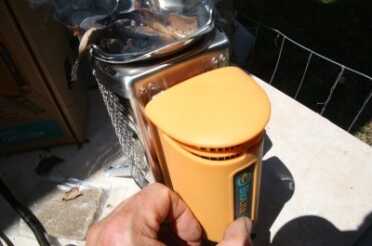

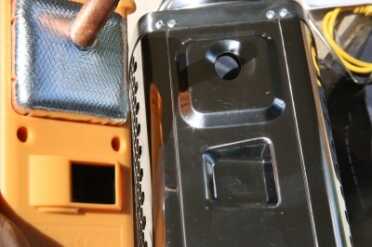
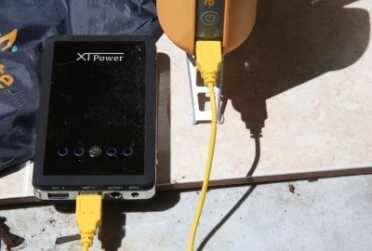
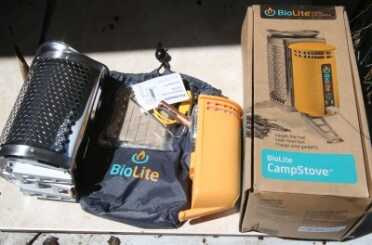


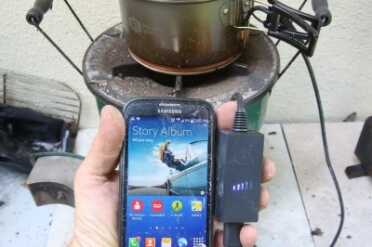


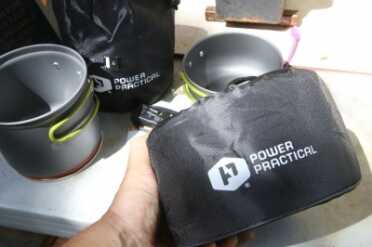



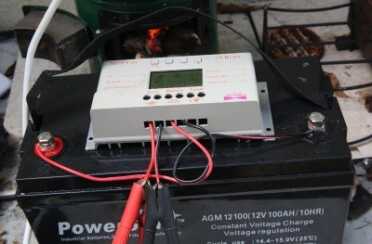
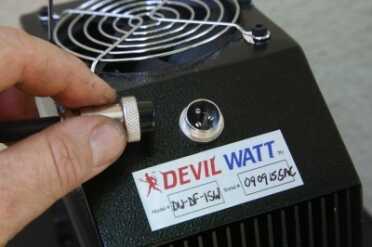
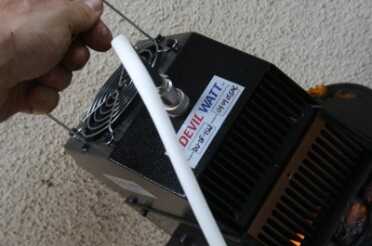
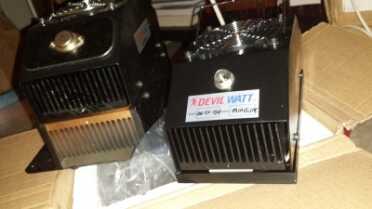

We ordered the 45 watt thermo electric generator – the Devil Watt.
It didn’t even charge the cell phone.
We sent the units back to the company a month ago and never heard from them.
Tegmart says they don’t do returns except on defective products, which these two were.
We are out around $1,400 to this company.
We like the concept, but it just didn’t work, especially for $750 each unit.
We don’t recommend Tegmart!
You get more power with a lot less fuss with solar cells. $20 will get you a 15 volt trickle charger for your car battery and you can charge most anything from a car battery. If you shop around you can get more power for your dollar pretty easily and all you have to do is set the thing out in the daylight. Direct sun is best but light is light. 45 watts for about $150 will charge your phones pretty quickly. I have to wonder though how the author expects the cell phone system to be up and running so he can talk to people if the situation is bad enough that you really have to bug out to survive. Cell phones are only short range com gear by themselves. They will rarely reach a cell tower over 5 or 10 miles away and if the cell towers are not powered you aren’t calling anyone. Get a CB radio for short range com, a base station that will run on DC and some walkie talkie types for carrying around. Even a good mobile mount makes a good base station. and if things really go bad nobody is going to be enforcing the 4 watt transmitting limit. Hard to do if the FCC is unmanned or can’t get fuel themselves. At night you can talk a long way depending on skip. Skip is atmospheric bending of the radio waves so that instead of being limited by the horizon you can talk across the country at times. I’ve talked to New Zealand a couple of times on 4 watts. I used to regularly talk to South Carolina from Southern California at night. If you’re a licensed Ham you can use a variety of the HF frequencies that are sometimes better for such methods. Up until at least 30 years ago the Air Force still used HF for most of their long range com gear and would scrub a mission if the HF radio wasn’t working. The equipment I worked on was mostly older tech than that. Still used tubes for a lot more than just the final power amps. Ask an old Air Force radio tech about an ARC-65. Not suitable for an emergency rig at all. 170 pound transceiver, 25 pound antenna coupler. Modern gear is way better and way more portable and a lot more efficient power usage wise. You really don’t need a kilowatt output to talk long distance. On the other hand, I have no idea how modern integrated circuits will hold up to a real EMP. I’ve read articles that say we’ll be using smoke signals. I’ve read articles that say it won’t do much of anything. I think it will be somewhere in between. Tube radios should be relatively immune to it if the effect is bad. Good luck finding one that works though. I suspect you won’t need much electrical power for other than lights and hopefully we are all just wasting our energy and it never really happens.
I have a thought for you. If things really go to pieces, what good is gold or silver? You can’t eat it. it’s won’t keep you warm at night nor will it cook your meals. Hard liquor is going to be much higher in demand. if worse comes to worse it can be used as an antiseptic and an anesthetic. Great trade goods. Down here in the southwest I think my biggest worry is going to be getting water.
Ladies and Gentlemen, 1st my bonafides, I am a licensed electrical contractor in the Socialist State of California, m,y specialty is life safety systems for hospitals, fire alarms, generators etc. as such I am constantly working with batteries and generators of all types.
First, a battery is not an electrolytic capacitor for long storage, a capacitor only stores a charge and wants to dump it quick, a battery produces a charge via chemical reaction, some of the chemistries can be recharged by reversing the reaction by pushing in a voltage that re-combines the elements (ions) that separated in the initial reaction. A 12volt DC battery (lead acid) likes to be charged at 13.2 or 14.4VDC depending on whether you are going for speed or a ‘trickle’ . Lithium cells have a bad habit of going BOOM when they are overheated, want to see, try throwing a dead 2032 ‘coin’ type battery in your next campfire. Keep your distance, goes off like a 12ga, and its the size of a dime.
As to wire size, resistance goes up and voltage goes down based on 3 factors, wire size (affects resistance) length and current. We call this voltage drop, if the wire is longer to the load and you can’t raise the voltage, make the wire bigger, by these calcs if your wire is only a few feet long size really doesn’t count because the resistance doesn’t build up.
A load, which is work, is based on voltage times current = watts, but since you usually can’t change the voltage of your device, it’s better to pick a device that uses DC voltage, (Ohm’s Law Volts X Amps = Watts), for instance a 100 watt regular light bulb is 100watts divided by 120 volts = .8 amps That same bulb on DC would be 100 watts divided by 12 VDC = 8 amps, notice the 10-1 ratio which matches the ratio of 120-12.
But anybody who uses a 100 watt bulb on DC is throwing away 90% of the power in the form of heat, just like regular bulbs, use LED’s made for DC, efficiency is awesome and almost no heat loss.
Now as to generators, there are 3 basic fuel types, diesel, gasoline and propane/NG, diesel is the most efficient, least likely to blow up and has a longer shelf life than gasoline, propane has a longer shelf life, is cheaper but would get hard to find quickly in a real SHTF scenario, unless you have your own refinery, as most propane is a byproduct of refining oil. Gasoline is probably the cheapest from an equipment standpoint but, short shelf life, even with additives, gonna get hard to find almost as fast.
Note: many propane generators will also run on NG, but they must be equipped for it , and they will not run the same NG has 12% less BTU than propane and if the unit is tuned for NG it will overspeed on propane and if tuned for propane will lug down on NG, neither of which is good. Generac makes a line of gensets that are rigged for both, literally change the fuel and flip a switch, I have them on my house and my BugOut spot #1, soon to be added to BO #2.
After all about fuel, for a long term SHTF diesel is probably the best as it is the easiest to produce (see biodiesel) from waste cooking oil, and most diesel engines don’t seem to care, only problem is that small diesel gensets are harder to find and are more expensive. I’ve run bio in my Chevy Duramax and there was no difference, just “Please Sir, can I have some more?”
Well that’s my 2 cents, and as they say on TV, ‘Be careful out there’
Tom
and you only have to keep your stove fire lit for 3 days to charge up that phone. charging at 4 watts for 4 or 5 minutes during cooking isnt gonna charge up any device.
nothing more than a gimmick as far as practical use goes. it would be better to just carry extra batteries than that heavy stove.
not good for backpacking, and if your car camping you have that battery source to fully charge your phone
I use rc lipo battery packs to power up and run sat. radio and charge up phone and flashlight batteries ( 18650’s) when out in the wilderness.
Focus on the essentials.. Not on gadgets… extraneous items..
Along with Beans, Bullets and Band aids… Fitness will be one of the most essential assets..
Follow the Rule of three otherwise..Minimize.
Vic
Interesting products. What good are they ? If I chose to ‘bug out’, I don`t want a cell ph. that can be tracked. Also, I`ve never been unable to start a cook fire, rain,snow,wind.
Lots of reasons bud. Recharging laser batteries. Having a Kindle or laptop with a DVD of stored emergency and how to articles (lot lighter than 40 books and manuals), recharging a GPS mapping system or handheld radio batteries. Learning to build a fire in bad conditions requires setting up a tarp or lean to shelter, having some starter fuel (look for old pine stumps) etc. Easy.
One of the downstream after the batteries reasons to run a higher voltage system concerns the size of the gauge of wire that you need to run in order to carry the current that you need to do what you want the current to do without excessive voltage drop.
The lower voltage that you use, the larger gauge wire sizes are necessary to get your current where you need it to go.
Which means that when you use a higher voltage system you can push more current to the point of use with a smaller gauge of wire.
I think that the reason that it is an issue has something to do with resistive losses to the wire itself. The larger diameter wire has lower resistance (to a point) than the smaller gauge wire and so permits flow of the lower voltage current with less losses.
Yes, it is the resistance, and the calculations for wire runs are really important both to get the voltage at the other end you expect, and for wire heating.
There seem to be much better batteries for long term power storage these days than Lead.
Which have significantly better cycle life compared to RC and most electric car lithium batteries, which, aside from cost; are themselves head and shoulders above using gel cells.
http://www.electriccarpartscompany.com/40Ah-6-20C-23V-br-Lithium-Titanium-Battery-br-108-53-11-in-275-135-29-mm-br-37-lbs-17-kg-br-h3-b-30000-Charge-Cycles-br-50-Year-Life-b-h3_p_221.html
Batteryspace.com has better options but you need a special charger for all lifepo batteries
I agree that battery space has an impressive selection of batteries.
However, those batteries which have an analog to the batteries at electric car parts are significantly more expensive than the ones at Electriccarparts dot com.
For instance the 60, 100, 200 ah prismatic lithium cells are $20-40 more per capacity segment at battery space vs Electriccarparts.
Regardless. You can pick up a Chevy Volt battery pack from EBay or a local wrecking yard for around $2k and rewire the cells to out put whatever voltage that you prefer.
I understand that 48v is a standard in larger format off grid systems.
Chevy Volt packs are 16 kWh worth of 24 and 48v packs strung together in series which have the option of water cooling.
Yes. Lithium batteries require their own type of charger, but, as you can get Solar charge controllers and AC chargers for all of the major battery chemistrys for about the same price as the lead acid solar charge controllers, I don’t see why you would cling to lead acid systems if you are at the Start of your home battery bank construction.
If you already have invested tens of thousands of dollars into lead acid, I get your reticence to accept new things.
If we are planning for teotwawki, would it not make sense to have the resources available to repurpose a Chevy volt, Nissan Leaf or Tesla’s battery pack to power our lives into the future?
If you go back to the last solar article here, you will see the 100ah lifepo batteries I got from batteryspace, but I have had issues with them becoming hot when charging them. I’ve had people out of hand tell me the dangers if lithium batteries with fire also. I think your ideas of stealing the batteries out of wrecked cars is great, but have you done it? That it always the rub with these comments. Whenever somneone says “you can just” it means they have an idea but haven’t tried it, and the trying is always the hard part. Armchair suggestions sound great, but the people out there doing power storage use lead acid. Do you even know why it would make more sense to run 24v rather than 12v?
I admit. My information is all secondhand.
But there is a place where they have done and are doing empirical testing of the ideas that I have suggested.
There is a wealth of information on the batteries up to and including destruction testing of the lithium cells. Both large and small format lifepo4 as well as the tesla, volt and leaf batteries.
Do not take my word for it.
The reason that higher voltage is better than low voltage, is that the higher voltage that you use, the lower current that you need to take from Each individual cell which makes up the battery.
For highest battery longevity, you should usually only take about 0.3C or about 30% of the current for the capacity of the particular battery (at least, insofar as lithium batteries go). For instance 30 amps of current out of a 90 ah battery.
If you size your pack in larger cell strings, either by going parallel cells or series cells you can reduce the current being demanded from a particular cell.
48v is about the lowest high voltage that is “safe” to use without taking more precautions.
Again, do not take my word for it.
http://www.diyelectriccar.com/forums/showthread.php?t=93101&highlight=Chevy+volt
http://www.diyelectriccar.com/forums/showthread.php?t=164113&highlight=Chevy+volt
http://www.diyelectriccar.com/forums/showthread.php?t=125890&highlight=Chevy+volt
That is the problem with most people online. Go and do something. Research isn’t going to do anything for you. If you think that solar is your thing, go buy some panels, a charge controller, and even 1 100ah lead acid battery, and make sure you have your connectors. Buy some 12v LED lighting. Get a Ham radio. Solar has its limits now because of the artificial cloudcover from the Solar Radiation Management planes spraying, but until you go put together your system and try it and use it, you won’t know what you have or how useful it’ll be.
Well, my only interest in bringing this up was so that your readers would know that there are other avenues of large scale battery back up available rather than large lead acid banks.
On the whole, I enjoyed your article as I have been watching Teg’s for several years now hoping that they were “Real”, not just some vaporware that you pay for and never get a functional working product in the mail.
I have been ogling the water cooled 100 watt devil watt for several years, in fact.
As for “do it”. I grew up on a homestead in Alaska, my dad was into alternate power sources, so I have lived with solar and wind powered battery banks and am aware of the drawbacks inherent to living on an off grid battery bank. Especially during the winters darkest months.
Power rationing is a real thing, one that none of my friends who have always lived in town on the grid seem to comprehend.
When your power comes from a battery pack, you are Far more conscious of that light that someone left on when they leave the house. I sometimes get mad when this happens in my own On grid home with my off grid mindset.
I have been working towards building a battery electric truck for 4×4 Offroad use. Which is where my research into using Chevy Volt cells comes from.
I am not to the installing batteries phase yet, so cannot tell you anything hands on as yet.
Using a battery pack in a vehicle is a much higher usage cycle than using one for off grid lighting. Since there are easily dozens to hundreds of people who are doing this conversion across this country as well as in other countries, I feel confident that the relatively low use of an off grid battery bank would be well within the Volt’s rather exceptional abilities. There are people who have used over 20C from the 47ah cells (around 900 amps for a few seconds). I doubt that any of your readers would abuse the cells this much unless they are building their own rail guns.. Did I mention that Volt cells are water cooled? 😉
Why would I want a battery electric 4×4? Full peak torque in a flat line from 0 rpm to 3,000 RPM.
I am diabetic, so I have a limited shelf life during any doomsday scenario. When my insulin runs out, so do I.
So I spend my prepping time on projects which May have some benefits for my loved ones after I am gone.
No gasoline or diesel to run your truck? No worries, long dead Phil built this nifty electric 4×4!
Lol. Practical? Maybe. Hopefully it will be fun.
Evalbum.com lots of people have built electric, very few of them are off road enthusiasts.
Checkout Zookev on YouTube for an example of a regular Joe who built an AC motor powered Suzuki Samurai for off-road use and powered it with Volt cells.
Off-road he can drive all day long (because he has it geared low and has low amp draw) and has a highway range of 30+ miles at freeway speeds. (The faster you go, the more air resistance losses.)
Yes, you can charge it with a generator for range extension.
JG in NJ, capacitors aren’t like batteries, they fully discharge all at once. Pat, yes you sure can! Aurthur, it’s OK to use your hands to place the paper wad logs on the drying grill/rack, you don’t have to do it genitally…unless you really want to, but I use mine for something else… 😉
Couple questions please. I have a wood stove in the kitchen. In the winter, I augment the propane furnace with wood heat so we can lower the thermostat on the furnace. Well that’s the plan till I run out of propane. What size is the battery you have for charging? The Devil Watt sounds like just the ticket to keep my phone and smaller batteries charged. Am I to understand you can put the Devil Watt atop the rocket stove for heat?
May I suggest an additional fuel. I have been using shredded paper from my shredder to make paper mache logs. I’m using two forms, a 2″ pvc pipe and 4″ split down held together by hose clamps. I let the paper soak a week or so, stuff and compress it into the forms. After a few days, I’ll undo the forms and genitally put the rolls on a pan and place them in an un-lite grill for a week or so, depending how hot the grill becomes to dry out the logs. I would not recommend lighting the grill. After drying out, they will smolder & burn with an extremely hot temperature and are hard to put out. I’m speaking from experience. The 2″ dia log is for the rocket stove and the 4″ dia for the wood stove.
You can get 100ah sealed gel batteries from solar supply and on ebay for a couple hundred bucks shipped. You can run as many of those in parallel as you want of course. Just use a charge controller.
I heat my house with wood it is not a out side stove can we generate power with this stove
The woodstove generators are for in the house use. I think they are probably more efficient too.
Seems that there is a need for a product with new features. A rocket stove with a fan to ease the starting problem the author referred to, a charger built in as in the BioLite, and super capacitor energy storage (for the fan) that would have a far longer reliable life under stressful conditions than a chemical battery.
A battery is essentially an electrolytic capacitor made to hold a charge longer. Regular motor start capacitors and electrolytic capacitors can’t hold much charge anyway. Battery life is of course an issue, but I’ve addressed that in my solar articles if you read them. You can get newer and very expensive 100ah lifpo batteries that have much more life cycles, and they should last indefinately for things like lights and electronics.
Up until last year Toyota was using a super capacitor to provide the hybrid power storage in their Le Mans racing cars. They shut off the gas engine and drive into the pits on the stored power and stop. Get refueled, change tires and driver and then drive out of the pits on stored power restarting the gas engine at pit exit. They also recharge via dynamic braking same as the battery systems and run motors same as the battery systems. They worked reliably for the 24 hour race, having pit stops about every 40 minutes. Not sure why they switched to batteries this year but the super capacitors do not operate under the same limitations as the capacitors used as ac motor starters nor the ones used for power smoothing in regular power supplies. I understand that the super capacitors operated at around the same 400 volts dc that the battery hybrids did. Just saying, super capacitors don’t have the limitations that a lot of commenters here seem to think they do.